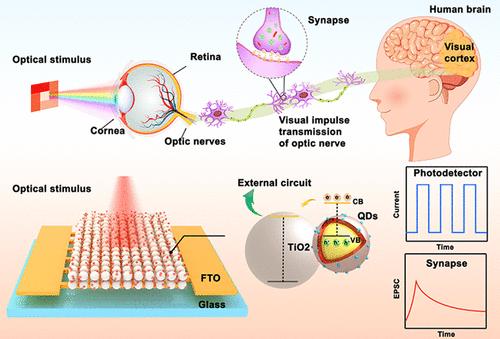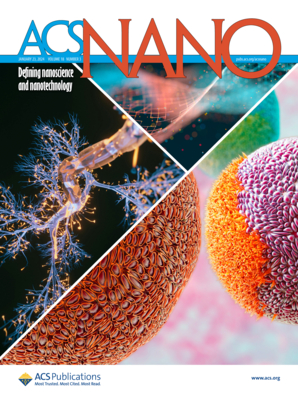为近红外光学突触和人工视觉系统量身定制的环境友好型反向 I 型胶体量子点
IF 15.8
1区 材料科学
Q1 CHEMISTRY, MULTIDISCIPLINARY
引用次数: 0
摘要
胶体量子点(QDs)由于具有溶液加工性和可调带隙,正在成为构建近红外(NIR)光电探测器(PDs)和人工光电突触的潜在候选材料。然而,目前大多数近红外 QDs 光电器件仍然是使用含有铅(Pb)和汞(Hg)等有害重金属的 QDs 制成的,存在潜在的健康和环境风险。在这项工作中,我们通过掺杂铜(Cu)定制了环保型反向一型 ZnSe/InP QDs,并将光响应从可见光区扩展到了近红外区。瞬态吸收光谱分析表明,ZnSe/InP:Cu QDs 中存在铜掺杂态,有利于提取光生电荷载流子,从而提高了光探测性能。具体来说,在 400 纳米光照下,掺杂铜的 ZnSe/InP QDs 基 PDs 具有从紫外线(UV)到近红外的宽带光探测性能,响应率为 70.5 A W-1,探测率为 2.8 × 1011 Jones,超过了未掺杂 ZnSe/InP QDs 基 PDs 的响应率(分别为 49.4 A W-1 和 1.9 × 1011 Jones)。更重要的是,ZnSe/InP:Cu QDs-PDs在近红外光照下表现出了短期可塑性(STP)、长期可塑性(LTP)和学习-生成-再学习等各种类似突触的特性,这些特性被进一步用于构建PD阵列器件,以模拟人工视觉系统,这在未来的光学神经形态应用中是可以实现的。本文章由计算机程序翻译,如有差异,请以英文原文为准。

Tailored Environment-Friendly Reverse Type-I Colloidal Quantum Dots for a Near-Infrared Optical Synapse and Artificial Vision System
Colloidal quantum dots (QDs) are emerging as potential candidates for constructing near-infrared (NIR) photodetectors (PDs) and artificial optoelectronic synapses due to solution processability and a tunable bandgap. However, most of the current NIR QDs-optoelectronic devices are still fabricated using QDs with incorporated harmful heavy metals of lead (Pb) and mercury (Hg), showing potential health and environment risks. In this work, we tailored eco-friendly reverse type-I ZnSe/InP QDs by copper (Cu) doping and extended the photoresponse from the visible to NIR region. Transient absorption spectroscopy analysis revealed the presence of Cu dopant states in ZnSe/InP:Cu QDs that facilitated the extraction of photogenerated charge carriers, leading to an enhanced photodetection performance. Specifically, under 400 nm illumination, the Cu-doped ZnSe/InP QDs-based PDs presented a broadband photodetection ranging from ultraviolet (UV) to NIR, with a responsivity of 70.5 A W–1 and detectivity of 2.8 × 1011 Jones, surpassing those of the undoped ZnSe/InP QDs-based PDs (49.4 A W–1 and 1.9 × 1011 Jones, respectively). More importantly, the ZnSe/InP:Cu QDs-PDs demonstrated various synapse-like characteristics of short-term plasticity (STP), long-term plasticity (LTP), and learning-forging-relearning under NIR light illumination, which were further used to construct PD array devices for simulating the artificial visual system that is available in prospective optical neuromorphic applications.
求助全文
通过发布文献求助,成功后即可免费获取论文全文。
去求助
来源期刊

ACS Nano
工程技术-材料科学:综合
CiteScore
26.00
自引率
4.10%
发文量
1627
审稿时长
1.7 months
期刊介绍:
ACS Nano, published monthly, serves as an international forum for comprehensive articles on nanoscience and nanotechnology research at the intersections of chemistry, biology, materials science, physics, and engineering. The journal fosters communication among scientists in these communities, facilitating collaboration, new research opportunities, and advancements through discoveries. ACS Nano covers synthesis, assembly, characterization, theory, and simulation of nanostructures, nanobiotechnology, nanofabrication, methods and tools for nanoscience and nanotechnology, and self- and directed-assembly. Alongside original research articles, it offers thorough reviews, perspectives on cutting-edge research, and discussions envisioning the future of nanoscience and nanotechnology.
 求助内容:
求助内容: 应助结果提醒方式:
应助结果提醒方式:


